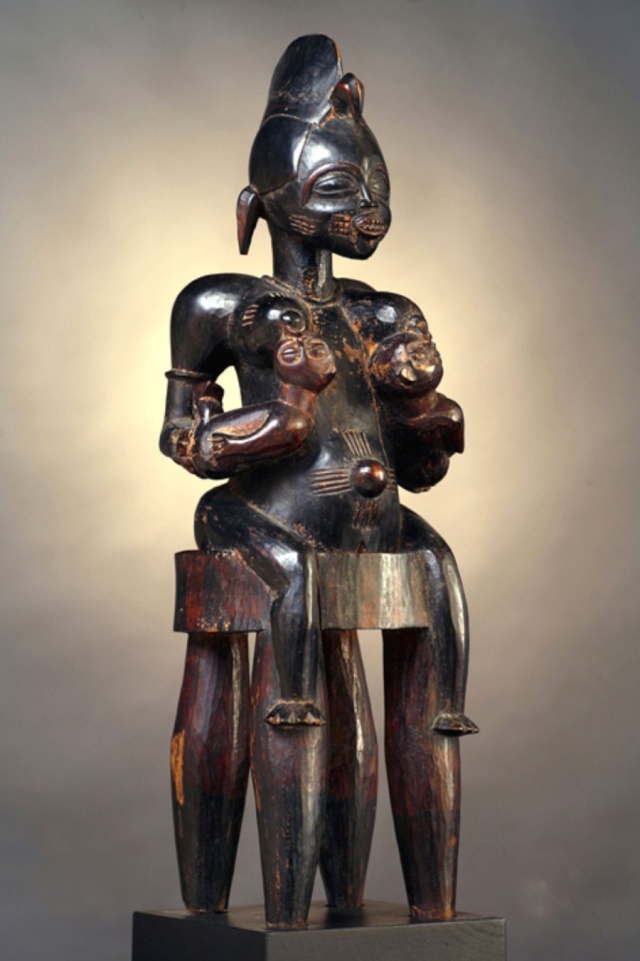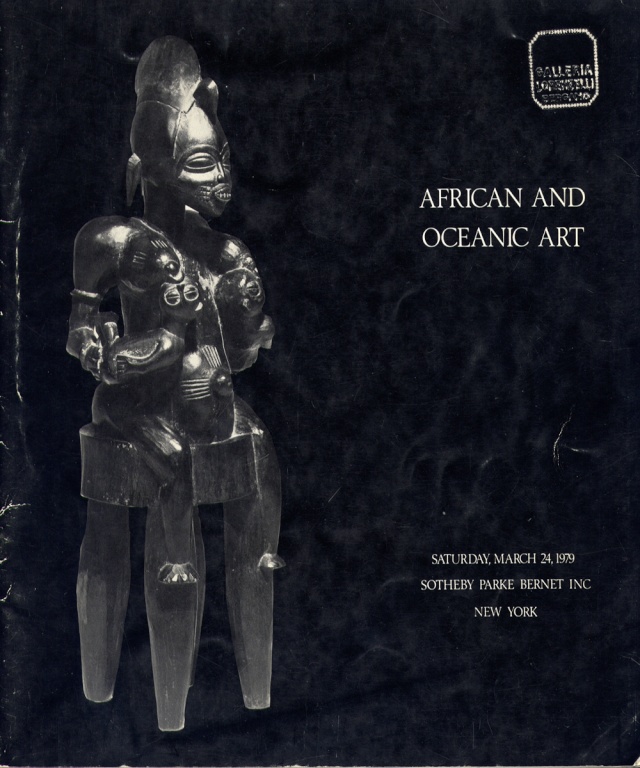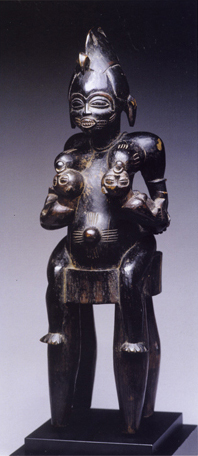Senufo people, Maternity Poro Society Figure (Nong), Korhogo Area, Ivory Coast
Pagina 1 di 1
 Senufo people, Maternity Poro Society Figure (Nong), Korhogo Area, Ivory Coast
Senufo people, Maternity Poro Society Figure (Nong), Korhogo Area, Ivory Coast

Senufo people, Maternity Poro Society Figure (Nong), Korhogo Area, Ivory Coast
H.18,2 in/ 45,7cm
Wood, deep reddish-black patina
19th century
Private collection, Italy
Photo by Pietro Paletti
Arti delle Mani Nere All Rights Reserved
Provenance(s):
- Jay C. Leff coll. Pennsylvania
- Jack Faxon coll. Detroit
- William W. Brill coll. New York
- Werner Muensterberger coll. New York
- Leonardo Vigorelli, Milano
Exibition(s):
-Senoefo: leven en welzijn, Afrika Museum, Berg en Dal, 1980
-Symbol van het moederschap, Galerie d’Eendt, Amsterdam 1982
-Perpetuating the culture. African Images of Mother and Child, Brookville, N.Y. Hillwood Art Museum/Long Island University, 26 August/5 October 2002
-Parcours des mondes, Paris 2004
-L’Africa delle Meraviglie. Arti Africane nelle collezioni italiane. Museo Palazzo Ducale, Genova, 31th December 2010 – 5th June 2011

Photo Courtesy Sotheby's
Published :
-Cover "African and Oceanic Art", Sotheby Parke Bernet Inc., New York, March 24, 1979, photo b/n pag. 44
-"Senoefo: leven en welzijn" , Afrika Museum, Berg en Dal, 1980, pag. 7, fig. 3 b/n
-"Symbol van het moederschap", Galerie d’Eendt, Amsterdam 1982, pag. 4, fig. 5 b/n
-Herbert M. Cole,“Perpetuating the culture. African Images of Mother and Child“ Brookville, N.Y. Hillwood Art Museum/Long Island University, 2002, pag.31
-"Kaos, Parcours des Mondes n.4", Picaron Editions, Paris, 2004, pag. 242 fig. color
-Burkhard Gottschalk,” Senoufo. Trésors inconnus des Collections privées, L’art du Continent noir. Afrique.Vol.3”, Verlag U. Gottschalk, Dusseldorf, 2009, pag 97, fig. color.
-Bargna I, e Parodi da Passano G.,” L'Africa delle meraviglie - Arti africane nelle collezioni italiane”, Genova, 2010, Silvana Editoriale, Cinisello Balsamo (MI), pag. 184
Long before Christian artists, africans were depicting women holding a child in their arms or breastfeeding to celebrate fertility and the harmony of the community-especially when infant mortality, the capturing of young adults for slavery and disease were endangering the group's survival.
(Alain-Michel Boyer)
Maternity Figure, seated on a high four-legged stool and holding her two children to her breasts, with domed navel surrounded by radiating scarification, sharply projecting breasts with scarification, cylindrical neck, pointed teeth bared, cicatrice marks on the cheeks. The whole composition, emphasised by a strong verticality, converges on a beautiful head with extremely marked features, embellished by an elaborate coiffure.
( Cat. Sotheby's)

"La sculpture provient d'un sculpteur du Nord dont autres statues sont également connus ( Holas 1975:78,79). Cet objet tient dans les bras des jumeaux dont les bouches ouvertes sont sous les mamelons de la mère. Ils ne tètent pas mais se norissent de savoir.Il est difficile de se représenter une mère primitive sous les traits de cette personne vigoureuse à la bouche souriante.Cette physionomie est typique de cette region."
(Burkhard Gottschalk 2009)
"Seated on a higth four-legged stool, this mother holds her twin children to her breasts. Her domed navel is surrounded by four sets of scarifications. Her sharply protruding breats also have scarification marks. Scarified cheeks accentuate her pointed protruding teeth. She wears an elaborate coiffure. The figure is covered with a deep reddish-black patina. This sculpture was included in an exhibit of Senufo art held in the Bergendal Museum in 1980."
(Herbert M. Cole 2002)
Bibliography:
-Delafosse, M. “ Le people Siéna ou Sénoufo”, Revue des etudes ethnographiques et sociologiques, 1:16-32, 79-92, 151-159, 242-275, 448-457,483-486; 2:1-21
-Goldwater, R. “Senufo Sculpture from West Africa”, The Museum of Primitive Art, New York, 1964
-Holas,B. “Image de la Mère dans l’art Ivorien”, Les Nouvelles Editions Africaines, Abidjan, 1975
-Holas, B. “L’Art Sacré Sénoufo", Abidjan, 1978
-Knops, P. “Les Anciens Sénoufo”, Musée Berg en Daal, 1980
-Gottschalk, B.”Sénoufo, Massa et les statues du poro”,Verlag U. Gottschalk, Dusseldorf, 2002
-Gottschalk, B.” Senoufo. Trésors inconnus des Collections privées,L’art du Continent noir. Afrique.Vol.3”, Verlag U. Gottschalk, Dusseldorf, 2009
Yale University Art Gallery, N.0038378-01

Photo Courtesy “Perpetuating the culture. African Images of Mother and Child“
Senufo people, Maternity Poro Society Figure (Nong), Korhogo Area, Ivory Coast
H. 45,7 cm
Legno, profonda patina rosso-nera
Fine XIX sec.
Collezione Privata, Italia
Foto Pietro Paletti
Arti delle Mani Nere All Rights Reserved
Provenienza:
- Coll. Jay C. Leff, Pennsylvania
- Coll. Jack Faxon, Detroit
- Coll. William W. Brill, New York
- Coll. Werner Muensterberger, New York
- Leonardo Vigorelli, Milano
Esposizioni:
-"Senoefo: leven en welzijn", Afrika Museum, Berg en Dal, 1980
-"Symbol van het moederschap", Galerie d’Eendt, Amsterdam 1982
-"Perpetuating the culture. African Images of Mother and Child", Brookville, N.Y. Hillwood Art Museum/Long Island University, 26 ago./5 ottob. 2002
-Parcours des mondes, Paris 2004
-"L’Africa delle Meraviglie. Arti Africane nelle collezioni italiane". Museo Palazzo Ducale, Genova, 31 dicembre 2010 - 5 giugno 2011
Pubblicazioni :
-Copertina "African and Oceanic Art", Sotheby Parke Bernet Inc., New York, 24 marzo 1979, fig. b/n pag. 44
-"Senoefo: leven en welzijn", Afrika Museum, Berg en Dal, 1980, pag. 7, fig. 3 b/n
-"Symbol van het moederschap", Galerie d’Eendt, Amsterdam 1982, pag. 4, fig. 5 b/n
-Herbert M. Cole,“Perpetuating the culture. African Images of Mother and Child“, Brookville, N.Y.:Hillwood Art Museum/Long Island University, 2002, pag.31
-"Kaos, Parcours des Mondes n.4", Picaron Editions, Paris, 2004, pag. 242 fig. color
-Burkhard Gottschalk, "Senoufo. Trésors inconnus des Collections privées, L’art du Continent noir. Afrique.Vol.3”, Verlag U. Gottschalk, Dusseldorf, 2009, pag 97, fig. color.
-Bargna I, Parodi da Passano G., "L'Africa delle meraviglie - Arti africane nelle collezioni italiane”, Genova, 2010, Silvana Editoriale, Cinisello Balsamo (MI), pag. 184
Molto prima degli artisti Cristiani, sono stati gli Africani a raffigurare l’immagine della donna con il bambino in grembo o durante l’ allattamento al seno, al fine di celebrare la fertilità e l'armonia della comunità, soprattutto quando la mortalità infantile, la cattura di giovani adulti per la schiavitù e le malattie minacciavano la sopravvivenza del gruppo.
(Alain-Michel Boyer)

Senufo woman. Published in: Himmelheber (Hans), “Negerkunst und Negerkünstler”, Braunschweig: Klinkhardt & Biermann, 1960:64, #53 (top left).
Figura di maternità seduta su un alto sgabello a quattro pioli che tiene i suoi due figli al seno, con ombelico a cupola circondato da scarificazioni che si irradiano intorno.
Il seno, fortemente sporgente, ha anch’esso scarificazioni , collo cilindrico, denti scoperti, cicatrici sulle guance. Tutta la composizione, sottolineata da una forte verticalità, converge su una bella testa con caratteristiche estremamente marcate, impreziosita da un'elaborata coiffure.
(Cat. Sotheby's)
"La scultura è di un artista del Nord del quale sono conosciuti altri esemplari (Holas 1975:78,79).

La figura ha tra le braccia due gemelli le cui bocche sono aperte sui capezzoli della madre che pare non stia allattando, ma trasmettendo la conoscenza. Appare difficile immaginare una madre primitiva nei panni di questa vigorosa figura dalla bocca sorridente.
Le caratteristiche fisiognomiche della scultura sono tipiche di questa regione (Korhogo)".
(Burkhard Gottschalk, 2009)
"Seduta su un alto sgabello a quattro pioli, la madre trattiene i figli gemelli al seno. Il suo ombelico a cupola è circondato da quattro gruppi di scarificazioni. I seni, nettamente sporgenti, sono anch’essi segnati da scarificazione come le guance che accentuano i denti digrignati. La figura esibisce un'elaborata coiffure . La scultura si caratterizza per una profonda patina rosso-nera. Questo oggetto è stato incluso in una mostra d'arte Senufo tenutasi presso il Museo Berg en Dal nel 1980."
(Herbert M. Cole 2002)
Bibliografia.
-Delafosse, M. “ Le people Siéna ou Sénoufo”, Revue des etudes ethnographiques et sociologiques, 1:16-32, 79-92, 151-159, 242-275, 448-457,483-486; 2:1-21
-Goldwater, R. “Senufo Sculpture from West Africa”, The Museum of Primitive Art, New York, 1964
-Holas, B. “Image de la Mère dans l’art Ivorien”, Les Nouvelles Editions Africaines, Abidjan, 1975
-Holas, B. “L’Art Sacré Sénoufo", Les Nouvelles Editions Africaines, Abidjan, 1978
-Knops, P. “Les Anciens Sénoufo”, Musée Berg en Daal, 1980
-Gottschalk, B.”Sénoufo, Massa et les statues du poro”, Verlag U. Gottschalk, Dusseldorf, 2002
-Gottschalk, B.”Senoufo. Trésors inconnus des Collections privées, L’art du Continent noir. Afrique.Vol.3”, Verlag U. Gottschalk, Dusseldorf, 2009
Opera registrata alla Yale University Art Gallery
Numero di archivio 0038378-01
 Argomenti simili
Argomenti simili» Agni people, Maternity Figure, Ivory Coast
» Senufo people, Waanyugo (or Waabele), Helmet Mask, Korhogo District, Ivory Coast
» Senufo people, Kpeli-Yehe mask, Ivory Coast
» Baoulé people, Gbèkrè, Monkey Figure (Mbotumbo), Ivory Coast
» Baoulé people, Gold weight, Ivory Coast
» Senufo people, Waanyugo (or Waabele), Helmet Mask, Korhogo District, Ivory Coast
» Senufo people, Kpeli-Yehe mask, Ivory Coast
» Baoulé people, Gbèkrè, Monkey Figure (Mbotumbo), Ivory Coast
» Baoulé people, Gold weight, Ivory Coast
Pagina 1 di 1
Permessi in questa sezione del forum:
Non puoi rispondere agli argomenti in questo forum.
 Indice
Indice